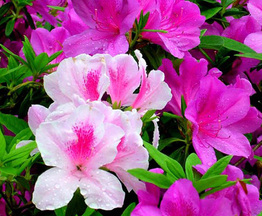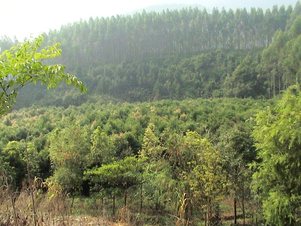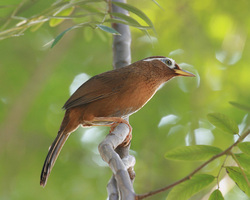Emblems of Shaoguan
Shaoguan has a rich and diverse variety of flora and fauna. It's unique landscape, visible in places such as the World Heritage listed Danxia Mountain formation is home to many rare flora and fauna. Officially, Shaoguan has floral, fauna (bird) and tree emblems.
Indian Azalea – Floral Emblem

The Indian Azalea was selected to be Shaoguan's floral emblem in 1986. Today the flower can be around the city on garden beds in parks and street islands around the city, which is aided by it's natural occurrence and ease of growth in Shaoguan. It is recognised as one of the ten most famous flowers of China. Indian Azaleas grow primarily in areas that don't have abundant sunshine in loosened and relatively acidic grounds (pH level 5.5-6.5). The flower grows naturally in red, purple, yellow, white, pink and blue varieties.
Camphor Tree – Tree Emblem

The Camphor tree is a tree native to southern Japan, southern China and across Indochina. Shaoguan boasts a one thousand year old Camphor tree in Shixing County. Examples of Camphor trees of up to two thousand years of age are known in other areas of China. Camphor trees are an evergreen tree that spreads it seed aggressively and can grow close to 30 metres tall. Camphor trees are hardy and can suit adapt to most conditions including drought-like conditions. It tolerates grounds with pH levels from 4.3 to 8.0. Its flowers are small and white and along with its leaves, are quite fragrant. The oil of the tree has long been used in Chinese traditional medicine for a range of purposes. Due to the abundance of the tree around Shaoguan and at the campus, much investigation and research has been conducted on the tree at Shaoguan University.
Hwamei - Bird Emblem
The Chinese Hwamei was selected to be the bird emblem of Shaoguan. Apart from Shaoguan, it is seen across Southern China, Laos and Vietnam. It can reach 25 cm in length with rounded wings and a fan tail. The bird eats fruits and insects and has a loud song. The males are timid, whilst the females are noted for their aggressive nature. Their feathers are a brownish colour and the name of the bird, Hwamei (In Chinese Hua mei) means painted eyebrow. This is in reference to the light coloured markings around its eyes. Its eggs are blue with sometimes traces of green and lives in small groups.

